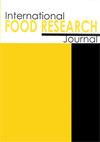Coagulation power comparison between fresh and powdered biduri (Calotropis gigantea) leaf extract in making suspesi soft cheese
IF 1
4区 农林科学
Q4 FOOD SCIENCE & TECHNOLOGY
引用次数: 0
Abstract
Cheeses have different characteristics based on the coagulant used during their production. Making suspesi soft cheese by adding biduri (Calotropis gigantea) leaf extract is generally followed by heating. The present work focused only on the ability of biduri leaf extracts to coagulate milk protein, and not on heating of the extract. The present work aimed to analyse the coagulation power of fresh and powdered biduri leaf extracts, and to evaluate the physicochemical, chemical, and organoleptic characteristics of the produced suspesi soft cheeses. The present work used a completely randomised design with two treatments and six replications. The variables measured were physicochemical characteristics, including coagulation time, curd production, whey percentage, pH, and lactic acid titration. Physicochemical characteristic analyses of suspesi soft cheeses coagulated with fresh and powdered biduri leaf extracts showed significant differences (p < 0.05) in the coagulation time and curd production. On the other hand, it did not show significant differences (p > 0.05) in the percentage of whey, pH, and lactic acid titration. The chemical content of suspesi soft cheeses showed significant differences (p < 0.05) in the water, protein, and crude fat contents. The organoleptic characteristics of suspesi soft cheeses showed a significant difference (p < 0.05) in the colour, but did not show significant differences (p > 0.05) in the smell, taste, and texture. Suspesi soft cheese produced with fresh biduri leaf extract had better coagulation power, physicochemical characteristics, chemical content, and organoleptic characteristics.鲜比杜丽叶提取物与粉末状比杜丽叶提取物制作软奶酪的混凝力比较
根据生产过程中使用的混凝剂的不同,奶酪具有不同的特性。加入比杜丽叶提取物制作软奶酪,然后加热。目前的工作只集中在比杜丽叶提取物凝固乳蛋白的能力上,而不是对提取物的加热。本研究旨在分析鲜比杜丽叶提取物和粉末状比杜丽叶提取物的混凝力,并评价生产的比杜丽软奶酪的理化、化学和感官特性。目前的研究采用完全随机设计,有2个治疗和6个重复。测量的变量是物理化学特性,包括凝固时间、凝乳产量、乳清百分比、pH和乳酸滴定。鲜比杜丽叶提取物和粉末状比杜丽叶提取物凝固后的悬浮软奶酪理化特性分析结果显示差异显著(p <0.05)影响凝乳时间和凝乳产量。另一方面,没有显示出显著差异(p >0.05),乳清百分比、pH、乳酸滴定。两种软奶酪的化学成分差异有统计学意义(p <0.05),在水、蛋白质和粗脂肪含量上。两种软奶酪的感官特征差异有统计学意义(p <0.05),但差异不显著(p >0.05)在气味、味道和质地上。用新鲜比杜丽叶提取物制备的悬浮软奶酪具有较好的凝固力、理化特性、化学成分和感官特性。
本文章由计算机程序翻译,如有差异,请以英文原文为准。
求助全文
约1分钟内获得全文
求助全文
来源期刊

international food research journal
Agricultural and Biological Sciences-Food Science
CiteScore
1.40
自引率
0.00%
发文量
75
期刊介绍:
The International Food Research Journal (IFRJ) publishes papers in English, six (6) issues a year with the coverage of:
Food Science and Technology
Nutrition and Dietetics
Agriculture, multidisciplinary
Chemistry, multidisciplinary
The scope of the Journal includes:
Food Science, Food Technology and Food Biotechnology
Product Development and Sensory Evaluation
Food Habits, Nutrition, and Health
Food Safety and Quality
Food Chemistry, Food Microbiology, Food Analysis and Testing
Food Engineering
Food Packaging
Food Waste Management
Food Entrepreneur
Food Regulatory
Post-Harvest Food Management
Food Supply Chain Management
Halal Food and Management
 求助内容:
求助内容: 应助结果提醒方式:
应助结果提醒方式:


